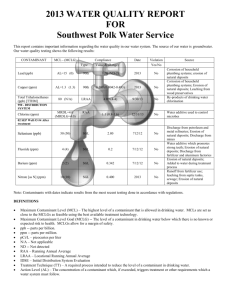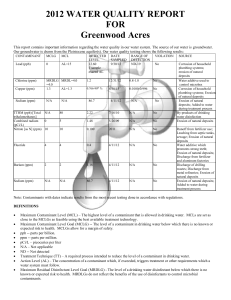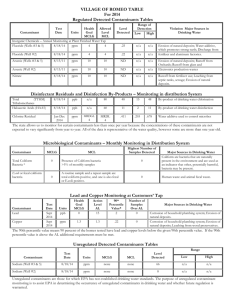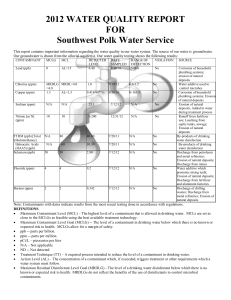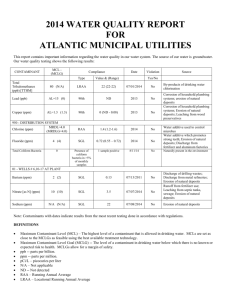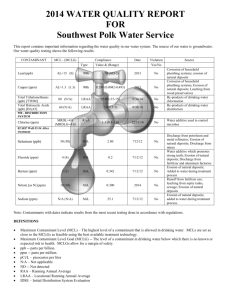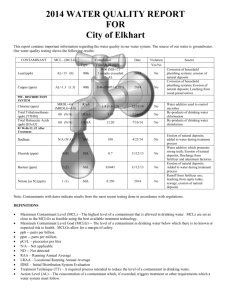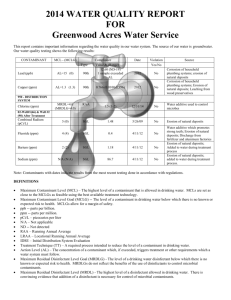irections for completing - Breezy Hill Water & Sewer Co., Inc.
advertisement
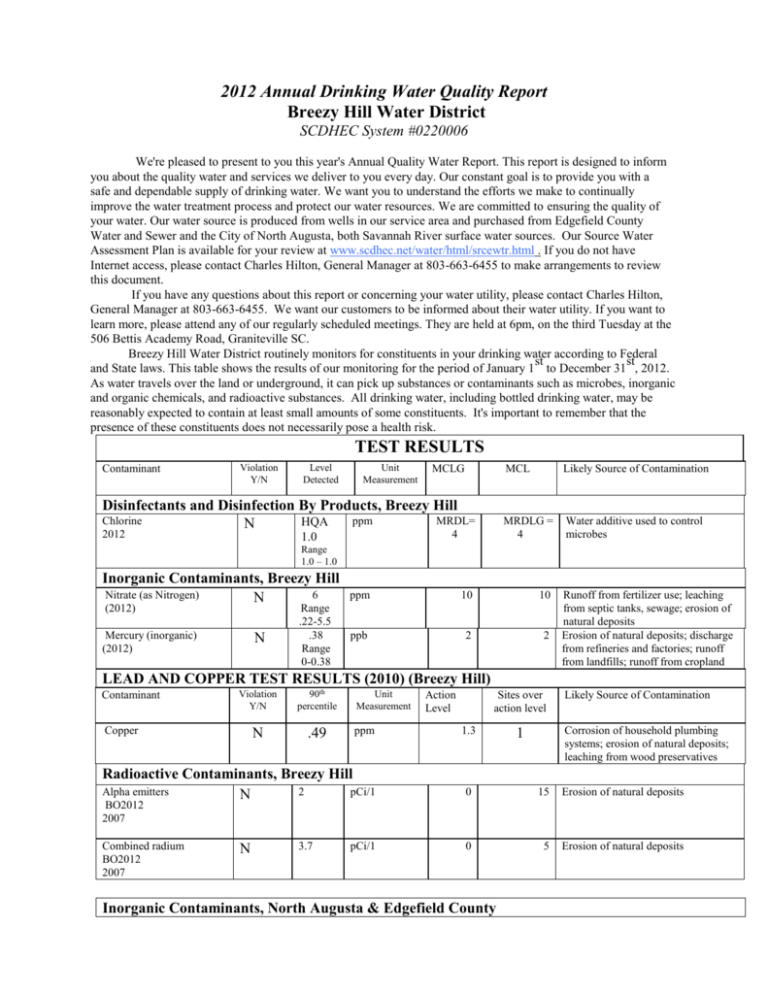
2012 Annual Drinking Water Quality Report Breezy Hill Water District SCDHEC System #0220006 We're pleased to present to you this year's Annual Quality Water Report. This report is designed to inform you about the quality water and services we deliver to you every day. Our constant goal is to provide you with a safe and dependable supply of drinking water. We want you to understand the efforts we make to continually improve the water treatment process and protect our water resources. We are committed to ensuring the quality of your water. Our water source is produced from wells in our service area and purchased from Edgefield County Water and Sewer and the City of North Augusta, both Savannah River surface water sources. Our Source Water Assessment Plan is available for your review at www.scdhec.net/water/html/srcewtr.html . If you do not have Internet access, please contact Charles Hilton, General Manager at 803-663-6455 to make arrangements to review this document. If you have any questions about this report or concerning your water utility, please contact Charles Hilton, General Manager at 803-663-6455. We want our customers to be informed about their water utility. If you want to learn more, please attend any of our regularly scheduled meetings. They are held at 6pm, on the third Tuesday at the 506 Bettis Academy Road, Graniteville SC. Breezy Hill Water District routinely monitors for constituents in your drinking water according to Federal st st and State laws. This table shows the results of our monitoring for the period of January 1 to December 31 , 2012. As water travels over the land or underground, it can pick up substances or contaminants such as microbes, inorganic and organic chemicals, and radioactive substances. All drinking water, including bottled drinking water, may be reasonably expected to contain at least small amounts of some constituents. It's important to remember that the presence of these constituents does not necessarily pose a health risk. TEST RESULTS Contaminant Violation Y/N Level Detected Unit Measurement MCLG Disinfectants and Disinfection By Products, Breezy Hill Chlorine ppm MRDL= HQA N 2012 4 1.0 MCL Likely Source of Contamination MRDLG = 4 Water additive used to control microbes Range 1.0 – 1.0 Inorganic Contaminants, Breezy Hill Nitrate (as Nitrogen) 6 N (2012) Mercury (inorganic) (2012) N Range .22-5.5 .38 Range 0-0.38 ppm 10 10 ppb 2 2 Runoff from fertilizer use; leaching from septic tanks, sewage; erosion of natural deposits Erosion of natural deposits; discharge from refineries and factories; runoff from landfills; runoff from cropland LEAD AND COPPER TEST RESULTS (2010) (Breezy Hill) Contaminant Violation Y/N 90th percentile N .49 Copper Unit Measurement ppm Radioactive Contaminants, Breezy Hill Alpha emitters 2 pCi/1 N Action Level Sites over action level 1.3 Likely Source of Contamination Corrosion of household plumbing systems; erosion of natural deposits; leaching from wood preservatives 1 0 15 Erosion of natural deposits 0 5 Erosion of natural deposits BO2012 2007 Combined radium BO2012 2007 N 3.7 pCi/1 Inorganic Contaminants, North Augusta & Edgefield County North Augusta Fluoride 2012 N 0.7 Range .68-.68 ppm North Augusta Nitrate (as Nitrogen) 2012 Edgefield County Fluoride 2012 N 0.073 Range .073-.073 0.6 Range .59-.59 ppm Edgefield County Nitrate (as Nitrogen) 2012 N 0.081 Range .081-.081 ppm N ppm 2 for DHEC 4 for EPA 10 2 for DHEC 4 for EPA 10 2 for DHEC 4for EPA 10 2 for DHEC 4for EPA 10 Erosion of natural deposits; water additive which promotes strong teeth; discharge from fertilizer and aluminum factories Runoff from fertilizer use; leaching from septic tanks, sewage; erosion of natural deposits Erosion of natural deposits; water additive which promotes strong teeth; discharge from fertilizer and aluminum factories Runoff from fertilizer use; leaching from septic tanks, sewage; erosion of natural deposits Non-Detects (ND) - laboratory analysis indicates that the constituent is not present. Parts per million (ppm) or Milligrams per liter (mg/l) - one part per million corresponds to one minute in two years or a single penny in $10,000. Parts per billion (ppb) or Micrograms per liter - one part per billion corresponds to one minute in 2,000 years, or a single penny in $10,000,000. Maximum Contaminant Level (MCL) - The “Maximum Allowed” (MCL) is the highest level of a contaminant that is allowed in drinking water. MCLs are set as close to the MCLGs as feasible using the best available treatment technology. Maximum Contaminant Level Goal (MCLG) - The “Goal”(MCLG) is the level of a contaminant in drinking water below which there is no known or expected risk to health. MCLGs allow for a margin of safety. Running Annual Average (RAA) – average of all samples in a year All sources of drinking water are subject to potential contamination by substances that are naturally occurring or man made. These substances can be microbes, inorganic or organic chemicals and radioactive substances. All drinking water, including bottled water, may reasonably be expected to contain at least small amounts of some contaminants. The presence of contaminants does not necessarily indicate that the water poses a health risk. More information about contaminants and potential health effects can be obtained by calling the Environmental Protection Agency’s Safe Drinking Water Hotline at 1-800-426-4791. If present, elevated lead levels can cause serous health problems, especially for pregnant women and young children. Lead in drinking water is primarily from materials and components associated with service lines and home plumbing. Breezy Hill Water District is responsible for providing high quality drinking water, but cannot control the variety of materials used in plumbing components. When your water has been sitting for several hours, you can minimize the potential for lead exposure by flushing your tap for 30 seconds to 2 minutes before using water for drinking or cooking. If you are concerned about lead in your drinking water, you may wish to have your water tested. Information on lead in drinking water, testing methods, and steps you can take to minimize exposure is available from the Safe Drinking Water Hotline or at http:/www.epa.gov/safewater/lead Some people may be more vulnerable to contaminants in drinking water than the general population. Immunocompromised persons such as persons with cancer undergoing chemotherapy, persons who have undergone organ transplants, people with HIV/AIDS or other immune system disorders, some elderly, and infants can be particularly at risk from infections. These people should seek advice about drinking water from their health care providers. EPA/CDC guidelines on appropriate means to lessen the risk of infection by cryptosporidium and other microbiological contaminants are available from the Safe Drinking Water Hotline 1-800-426-4791. Nitrate in drinking water at levels above 10 ppm is a health risk for infants of less than six months of age. High nitrate levels in drinking water can cause blue baby syndrome. Nitrate levels may rise quickly for short periods of time because of rainfall or agriculture activity. If you are caring for an infant you should ask advice from your health care provider.


